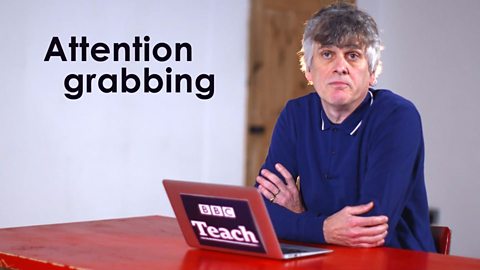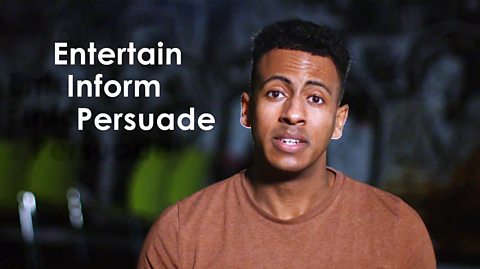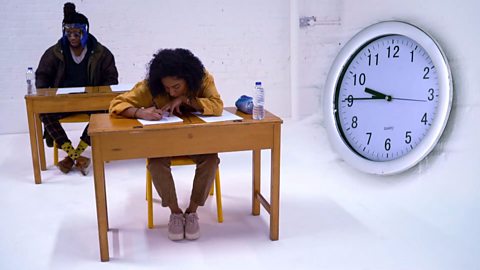Theresa Lola (VO):
Analysing fiction is working out and demonstrating how a piece of writing works. In this film, we'll examine a fictional text, and investigate the language the writer uses.
Theresa Lola:
Sons and Lovers is a 1913 novel by the English writer, D.H. Lawrence.
Theresa Lola (VO):
We'll be using exerts from this book, and exploring the range of techniques that the author uses to bring his writing to life. To analyse fiction successfully, you'll need to recognise these commonly used literary devices when they appear in a text. In this film, two contemporary writers, me, Theresa Lola: , poet, and Kathryn Evans: , an award-winning author of teenage fiction, will show you how.
Theresa Lola:
In this extract you're about to hear, Paul, the main character, is with his mother. He's recently won first prize in the painting competition, and been invited to go out to formal dinners with other artists. "He went out to dinner several times in his evening suit, that had been William's. Each time, his mother's heart was firm with pride and joy." The line that says "each time, his mother's heart is firm with pride and joy," I thought the use of the word "firm" was very interesting. I think it gives us a solid understanding of her love for her child.
Kathryn Evans:
I agree. It's an unusual word to use, connected with the heart, the choice of language. But I think it tells us something more about her, it tells us that she's determined, that implies that grim determination, she's firm about this for her son.
Theresa Lola:
Strong-willed, perhaps, yes.
Kathryn Evans:
Very strong-willed. But also, it's the pride and joy, those two words tell us how she feels about her son. She has enjoyment from him, she's proud of him. I love that line, it says so much in such a, a short space.
Theresa Lola:
Characterisation is the way writers create characters, and make them believable. An author creates characters using language. We learn about characters in lots of ways, from direct description, as well as dialogue. "He told her everything that took place, everything that was said. It was as if she had been there."
Kathryn Evans:
It says two things, it says that he's explained every detail of that dinner to her, but also perhaps that, she's constantly on his mind.
Theresa Lola:
That's exactly what I was thinking, he wants her to feel like she has been everywhere that she has been, to experience everything that he's experiencing. "And he was dying to introduce her to these new friends who had dinner at seven-thirty in the evening." He was dying to introduce her to his friend, shows kind of the desperation to please her.
Kathryn Evans:
I thought that actually, it's an interesting use of that word, "dying." It really does show his deep desire to share his new world with his mother.
Theresa Lola:
"Because you are quite as clever as I am."
Kathryn Evans:
And he flatters her, doesn't he?
Theresa Lola:
Yes.
Kathryn Evans:
When he says, "you are quite as clever as I am."
Theresa Lola:
Yes, definitely. I think it's a, a very heart-warming relationship, definitely. Trying to make the other feel good, perhaps, yeah. "But she began to spare her hands. They, too, were worked-gnarled now."
Kathryn Evans:
"Her hands were work-gnarled now," that tells us that she's a grafter. So, class is a very important issue I think, and that's why it's emphasised.
Theresa Lola:
"Then she sniffed in her sarcastic manner."
Kathryn Evans:
Maybe she's not 100% likeable, what do you think?
Theresa Lola:
Could possibly be her kind of laughing at herself and just, kind of laughing at how absurd the whole thing is, in a self-depreciating way.
Theresa Lola:
It's not just characterisation that makes the book believable, it's also the setting. Setting is a location where, and the time when events take place. Setting can play a crucial part in establishing atmosphere, and reflecting theme and character.
Theresa Lola:
"He went out to dinner several times in his evening suit."
Theresa Lola:
That definitely gives us the sense that, this extract is dated.
Kathryn Evans:
That's true, that they have to dress for dinner.
Theresa Lola:
"These new friends who had a dinner at seven-thirty in the evening."
Theresa Lola:
Back then, I think richer people would have dinner around that time, at 7:30, and people at working class would have their dinner around 5:30. So the excitement about having dinner at that particular time tells us that this is not something that they're used to.
Kathryn Evans:
Yeah, so we learn a couple of things. That, probably, the setting is, certainly not modern times, maybe early 20th century.
Theresa Lola:
Yes, definitely.
Kathryn Evans:
And that it's working class, these people are working class.
Theresa Lola:
Think that we can definitely see that the son is an outsider looking in, excited to tell his mother about these new friends he's met that have dinner at 7:30. So, it's definitely a major theme. I think another theme, as well, is probably the relationship between mother and son. We see them constantly complimenting each other and flattering each other.
Theresa Lola:
Writers use a variety of literary techniques to add depth and colour to their writing. Pay attention to the particular words and phrases that writers use to create their characters and set their scenes. Notice how they use adjectives, nouns, verbs, and adverbs. Also pay attention to their use of simile, metaphor, alliteration, and other literary devices, to create their characters and set their scenes.
Theresa Lola:
"He had shovelled away all of the beliefs that would hamper him, had cleared the ground, and come more or less to the bedrock of belief that one should feel in oneself for right and wrong."
Kathryn Evans:
I have to mention this lovely metaphor, language that immediately brings to mind tools to do with digging, shovelling, the ground, he says the ground, the bedrock. It feels earthy, that language, and I think, again, it places the characters in their working class environment.
Theresa Lola:
Shovelled away, cleared the ground, those verbs are very intense and it shows kind of this, desperation to move out of the class that they're in, and I was also very interested with the, adjectives that were used. There's this particular section where the mother's hands are described as work-gnarled and the skin was shiny.
Kathryn Evans:
It's so vivid you get a real picture of what this woman's hands look like, in the adjectives that he's chosen to describe her.
Theresa Lola (VO):
When you're in an English language exam, read the extract all the way through, then read the questions. Be sure of what you are being asked to do, and then read the extract again, highlight or underline interesting words, phrases, or sentences, and make note on these in the margin. Look closely at the writer's language choices, think about the effects these words might have on the reader. Remember, characters, setting, and theme, all shown to the reader through language and literary techniques. When you are happy, start your answer.
Video summary
Over the course of this video author Kathryn Evans and poet Theresa Lola analyse and examine extracts from the novel βSons and Loversβ by DH Lawrence.
This short film is intended to support students looking to improve their grade on the GSCE English language paper.
Following an initial discussion of the importance of note-taking, the film then leads into Kathryn Evans and Theresa Lola deconstructing an extract from βSons and Loversβ.
The film will help students understand how to examine various factors of a literary fiction text, including characterisation, setting, tone and the literary techniques that the writer uses.
At the end of the film is a recap on everything that Kathryn and Theresa have covered to summarise all the various points that your students will need to discuss in their exam for a good pass level.
This short film is from the ΒιΆΉΤΌΕΔ series, GCSE English Language.
Teacher Notes
Before watching
You could ask your students to work in pairs to analyse a copy of the extract from DH Lawrence's 'Sons and Lovers' (Chapter 10 from beginning to βNow life interested him more.β), to examine and discuss first, before watching this short film.
This short film will help students understand how to examine various factors of a literary fiction text, including characterisation, setting, tone and the literary techniques that the writer uses.
Pulling out key elements such as the setting of the extract, for example, when the son wants to introduce his Mother to his friends βwho had dinner at seven-thirty in the eveningβ establishes that this text was set in the early 20th Century.
This short film highlights key language techniques and should generate discussion amongst students.
Key language techniques will be reinforced and appear on screen.
Watch the video and see whether the writers pick out similar or different quotations to the students.
During watching
During viewing, you can pause the film to discuss how students' responses to the texts compare with the responses of Kathryn and Theresa.
Suggestions of pause points:
Pause point: 1:20
- What do we learn about Paul and his mother from these sentences? What do we learn about their relationship?
Pause point: 2:36
- What do you think this quotation reveals about the relationship between mother and son?
Pause point: 3:52
- What do we learn about Paulβs mother from the compound adjective in this quote?
Pause point: 5:17
- What have we learned about the setting of the extract?
Pause point: 6:34
- What do you notice about the language that the writer uses here? What are the words connected with?
After Watching
Students could imagine that they are going to prepare their own discussion of another paragraph from the extract.
Each pair should present their thoughts to the class, leading to a discussion including the whole class.
Next Steps
Students could then go on to look at past papers and predict the sorts of questions that would be asked about this extract.
They could use these questions to write their responses and gain a greater understanding of what will be asked of them during their examinations.
This short film is suitable for teaching English language at GCSE in England, Wales and Northern Ireland and National 4 and 5 in Scotland.
Analysing Literary Non-fiction. video
Tim Moore and Anna James individually analyse non-fiction texts and explain how to plan an exam answer.

Comparing Texts. video
Presenter Kyle Walker compares two texts about Manchester and introduces helpful tools such as mind maps or Venn diagrams.

Creative Writing in an Exam. video
Storyteller Sophia Thakur and performance poet Solomon O.B. sit a mock English language GSCE exam to demonstrate approaches to creative writing tasks.
